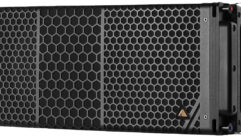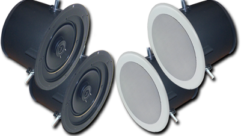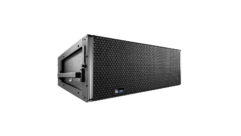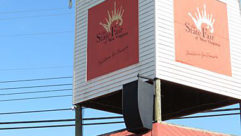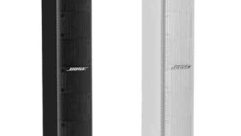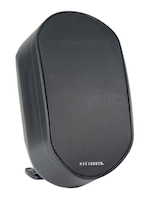

WorxAudio I/O-4 Speaker
Sep 22, 2011 10:47 AM,
by John McJunkin
A small-format two-way speaker ideal indoors and out.
WorxAudio I/O-4 Speaker
WorxAudio has introduced a small-format, high-performance speaker intended for use in both foreground and background applications, both indoor and outdoor. The I/O-4 features two 4in. LF drivers and a single HF driver with a 1in. exit. Upon taking the pair out of the shipping box, I had a gut instinct that these speakers would be able to deliver both fidelity and substantial SPL. I found myself a bit amused at the “armadillo” molding of the rear of the black polycarbonate that forms the speaker’s enclosure, and I found the front-facing surface of the speaker very attractive. Considering the black or white color options, I decided that these speakers would look nice in virtually any application. Another attribute of the speakers that struck me when I unboxed them was their heft—they weigh in at 11lb. each. That kind of mass says one thing to me: big magnets, which in turn says substantial woofers, and finally in turn, that tells me that these speakers would be well capable of delivering the goods in terms of low end. In the process of reading through the speakers’ literature, I discovered that their HF driver featured an exit aperture of 1in. in diameter, indicating the capacity to deliver pretty solid SPL. By all outward appearances, these speakers led me to conclude that they would be able to deliver plenty of SPL across the spectrum, but in terms of fidelity, how would they sound?
Before connecting them to get a listen, I reviewed the speakers’ specifications to get a handle on what to expect. The nominal impedance of the speaker is 8Ω, and via a multi-tap transformer, the speaker can accommodate multiple amplification scenarios, including power ratings of 12.5W, 25W, 50W, and 100V for distributed systems. It took me a moment to find the rotary switch on the rear of the speaker that determines which transformer tap is engaged. It’s deeply recessed and requires the insertion of a flathead screwdriver to turn it. The thing I love about it, and the reason I didn’t locate it immediately, its the round, soft rubber plug that pops into its recessed socket. It lies nice and flat against the rear surface of the speaker in a very unobtrusive way, and it protects the socket from wind and weather. Once I discovered that, I recognized that the rectangular piece of black rubber below it protected the speaker’s push terminal connectors. This plug has the same curved contour as the rear of the speaker enclosure, and it features a hole of roughly 3/16in. in diameter through which the speaker lead can be passed. I would guess that just the presence of the wire through the hole would seal out all but the most persistent raindrops, and if that were not robust enough, silicon caulk could be used to absolutely seal the hole. Similarly, the entirety of both plugs could probably be sealed in place with silicon for maximum water/weather resistance.
The front grille of the speaker is a robust powder-coated steel mesh with thin cloth behind it. It curves gently toward the back at top and bottom. I’m guessing that the cloth would largely qualify as acoustically transparent. While these speakers are rated by the manufacturer for use indoors or outdoors, I would not place them in such a way that the front face of the speakers would ever take direct rain or other substantial moisture. I would guess that the majority of the time, the contractor will be able to find a way to locate the speaker high and direct it groundward, which will solve the majority of rain-oriented difficulties. The aforementioned rotary switch and push terminals dominate the bottom half of the enclosure’s rear side, and the top is comprised of a recessed receptacle for the speaker’s plastic mounting bracket, which is actuated in two axes. This mechanism makes placement of the speaker and precise direction of its energy pretty simple business. The mount doesn’t feel super substantial to me—not flimsy but not solid either. Metal may be a better choice than plastic here.
I powered the pair of I/O-4s with a 100W amplifier with the rotary switch in the direct position and with impedance matched at 8Ω. I listened to a broad array of musical genres and recorded speech, along with radio and television broadcasts. My first general impression can be summarized in a word: intelligibility. Considering the typical applications for this type of speaker (frequently used for paging and other types of public address), this is a key attribute, and this speaker has intelligibility in spades.
The excellent intelligibility is largely the result of the speaker’s high end being hyped a bit. After quite a bit of listening, I decided that it might even be a little fatiguing. But I must disclose that I tend to critically listen with perhaps an unfair sense of comparison to studio monitors. And studio monitors these are not, and they do sound hypey in the high end, but that must be tempered with the consideration that many of the applications in which they will be used are noisy environments where the public address or paging must cut through the clutter. For that purpose, the hypey high end is perfect.
The physical heftiness of the speakers led me initially to expect substantial low end from the speakers, presuming large woofer magnets moving plenty of air. I was a little disappointed in this domain. The two 4in. speakers deliver pretty solidly down to probably 100Hz-125Hz (subjectively, I did not measure objectively) and sound very good in that spectrum. Below that, however, there is not much. I was curious if these speakers would benefit from the introduction of a subwoofer, so I brought a 10in. sub into the picture. The result of this was nothing short of stunning. WorxAudio has subwoofers available, but any competent contractor could marry virtually any sub with these speakers and arrive at spectacular results.
The crossover point in these two-way speakers is not published in the manufacturer specs, so I listened to try to hear it, and I’ll freely admit that I don’t have the ears to distinguish it. This is a strong testament to the design; the speaker delivers its entire spectrum very smoothly. The 75-by-50-degree dispersion pattern allows for some control in the direction of energy—and within the pattern there are no hot or dead spots or beaminess—to my ear. The maximum rated SPL output is 105dB continuous—not super loud, but they’re not intended as rock-n-roll sound reinforcement speakers either. When coupled with a sub, they actually do rock. One other major attribute of these speakers that really impressed me was the lack of distortion. Even at the very highest SPLs, I could hear zero audible distortion. I like that a lot.
WorxAudio I/O-4 Speaker
Sep 22, 2011 10:47 AM,
by John McJunkin
A small-format two-way speaker ideal indoors and out.
Bottom line: For the likely applications in which these speakers would be specified, they really shine. They’re not perfect, but they’re not expensive, and I would rate their bang-for-the-buck quite high. I would definitely specify these speakers for any of the types of installs touted by the manufacturer—restaurant, retail, corporate/industrial, theatrical, bar/hotel, and under-balcony fill.
John McJunkin is the principal of Avalon Podcasting in Chandler, Ariz. He has consulted in the development of studios and installations and provides high-quality podcast production services.
Product Summary
- Company: WorxAudio
www.worxaudio.com - Product: I/O-4
- Pros: Excellent voice intelligibility, energy dispersion consistent, low distortion
- Cons: Sub necessary for true, full low end, mounting bracket could be more substantial
- Applications: Restaurant, retail, corporate/industrial, theatrical, bar/hotel, under-balcony fill
- Price: $230
Specifications
- Nominal Impedance 8Ω (Switchable)
- Transformer Type: Isolate 12.5W, 25W, 50W/100V
- Components L F: 4” (101.6 mm) x 2
HF: 1” Exit (25.4 mm) x 1 - Titanium Diaphragm Passive Network x 1
- Pressure Sensitivity 2.83V: 87dB (1W/1m)
- Frequency Range (-10dB) 75Hz-19kHz
- Frequency Response (-3dB) 80Hz-18kHz
- Maximum Continuous SPL Passive: 105dB @1M
- Coverage Angles Horizontal: 75 degrees (-6dB)
Vertical: 50 degrees (-6dB) - Power Capacity Noise (IEC 268-5): 50W
Maximum: 100W - Type 3-way full-range bass reflex
- Enclosure Injection molded high-impact polycarbonate
- Hardware Finish Color Black or white
- Grille Powder-coated steel mesh
- Connectors Push terminal


